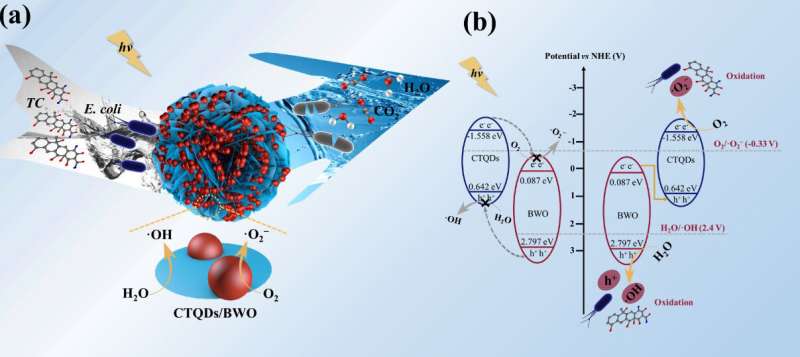Schematic illustration of photocatalytic mechanism. Credit: YANG Pengqi
In recent years, rapid industrialization has caused increasingly severe environmental pollution. Antibiotics and microbiological contamination in water have become major threats to human health and critical risks to ecosystem security worldwide. Therefore, an effective treatment approach has become an urgent task for elimination of bacterial and antibiotic contamination from the watery environment at present.
Recently, a team led by Prof. Wu Zhengyan from the Institute of Intelligent Machines of the Hefei Institutes of Physical Science developed a novel Z-scheme photocatalyst to deal with contaminants in water.
In a study published in the journal Applied Catalysis B: Environmental, Prof. WU and his doctoral student YANG Pengqi described how they used hydrothermal method to fabricate the Z-scheme photocatalyst, CdTe quantum dots/Bi2WO6 (CTQDs/BWO), which was designed to enhance photocatalytic efficiency.
As quantum effect dramatically promoted the transfer of charge-carriers in the interface of BWO and CTQDs, this photocatalyst exhibited much higher photoinactivation efficiency of E. coli and photodegradation efficiency of TC compared to the pure BWO under the visible light.
This study opens up a new route to design high-efficiency Z-scheme photocatalysts and exhibits a promising prospect for practical application.
More information: Pengqi Yang et al. Kinetics, reaction pathways, and mechanism investigation for improved environmental remediation by 0D/3D CdTe/Bi2WO6 Z-scheme catalyst, Applied Catalysis B: Environmental (2021). DOI: 10.1016/j.apcatb.2021.119877
Journal information: Applied Catalysis B: Environmental
Provided by Chinese Academy of Sciences
























